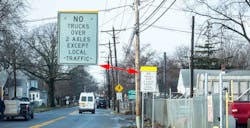A new law that allows use of camera-monitoring systems to keep trucks off prohibited roads was just enacted in Delaware, but the head of that state's trucking association fears that it could be misused. He described the law as "overkill."
The legislation allows all municipalities to install “vehicle height monitoring systems,” said M. Lee Derrickson, executive director of the Delaware Motor Transport Association and a former driver. "To allow every municipality and county in the state to install vehicle height monitoring is overkill. What they have in Baltimore makes more sense."
Derrickson is referring to a law in neighboring Maryland that allowed the city of Baltimore to install such devices. The Delaware law is believed to be the only measure covering an entire state.
Derrickson called the measure too broad in its scope because it includes all jurisdictions in the state, when the main problem is near the Port Wilmington.
He said the poor signage on roads leading to and from the port is to blame for truckers ending up on prohibited roads. Lambson Lane, in particular, is a problem for residents who complain about truck traffic.
Trucks are permitted on the eastern end of the street for several blocks, but then come upon a sign prohibiting truck traffic.
"Getting turned around there is very difficult, so most drivers just blast on through the residential area to S.R. 9," said Derrickson, adding that the main scofflaws are out-of-town drivers who trust their GPS too much.
"In that particular area - Lambson Lane - a truck makes a right turn, following their GPS, makes that right turn, sees the sign but can’t back out," he said.
Derrickson also pointed out many truck drivers are not using phone apps that could warn them about the truck prohibition.
The truck owner captured by a vehicle height monitoring camera is liable for the violation, unless the owner can demonstrate that someone else was driving. The first violation will yield a warning notice with no fine. A second violation is a $250 fine and subsequent violations will cost $500 each. State agencies will soon begin seeking vendors for the equipment.
"A violation may not be used to assess points on the person's driver license, recorded on the person's driving record, treated as a parking violation, or considered in the provision of motor vehicle insurance coverage," the law states.
Derrickson also told Fleet Owner a related issue in Delaware is that "there is no statewide inventory of truck routes. That needs to be addressed. We're willing to work with the state to create a map of legal truck routes."
About the Author

Larry Kahaner
Larry Kahaner is an author, journalist, and former FleetOwner contributor.
